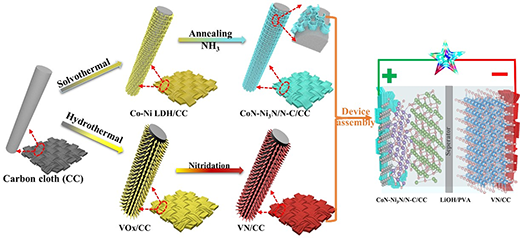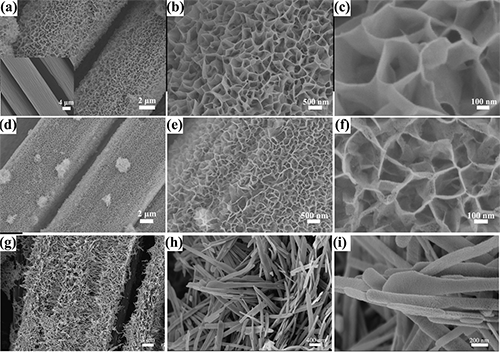| Jun 07, 2021 |
Integrated electrodes for high-energy-density flexible supercapacitors
(Nanowerk News) A research team led by Prof. ZHAO Bangchuan from the Institute of Solid Materials of the Hefei Institutes of Physical Science (HFIPS) synthesized 3D porous honeycomb-like CoN-Ni3N/N-C nanosheets and vanadium nitride (VN) nanobelt arrays via in-situ growth method, respectively, and constructed a high-energy-density flexible supercapacitor device.
|
|
The result has been published in Advanced Functional Materials ("3D Porous Honeycomb-Like CoN-Ni3N/N-C Nanosheets Integrated Electrode for High-Energy-Density Flexible Supercapacitor").
|
 |
| Figure 1. Schematic diagram of the formation process of CoN-Ni3N/N-C/CC, VN/CC, and the assembly of the flexible quasi-solid-state asymmetric supercapacitor device. (Image: LI Kunzhen) (click on image to enlarge)
|
|
Transition metal nitrides (TMNs) are potential electrode materials for high-performance energy storage devices, but the structural instability severely hinders their application. Therefore it is urgent to construct advanced cathode materials for flexible, wearable, long-life and high-energy-density energy storage devices.
|
|
In this research, scientists designed and fabricated an integrated cathode with 3D porous honeycomb-like CoN-Ni3N/N-C nanosheets, which were grown on flexible carbon cloth (CC) via a mild solvothermal method after post-nitrogenizing treatment.
|
|
Further experiments proved that the intrinsic conductivity was enhanced, and concentration of the active sites was increased. It gives advantage to the optimized CoN-Ni3N/N-C/CC, which can be used as an integrated electrode for the supercapacitor to achieves remarkable electrochemical performance.
|
 |
| Figure 2. SEM images of (a-c) Co-Ni LDH/CC, (d-f) CoN-Ni3N/N-C/CC, and (g-i)VN/CC at different magnification. (Image: LI Kunzhen) (click on image to enlarge)
|
|
This supercapacitor delivers an excellent energy density of 106 µWh cm2 with maximum power density of 40 mW cm2, displaying an outstanding cycle stability.
|
|
This work provides a viable strategy to construct high-energy flexible wearable electronics in next-generation electrochemical energy storage field.
|


